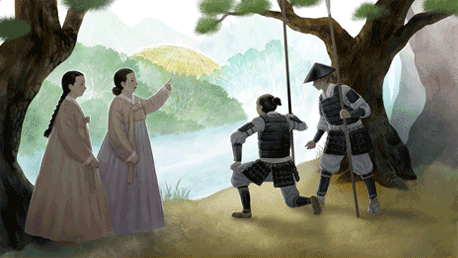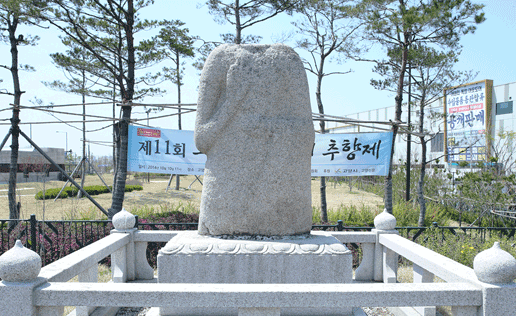Cultural heritage in Goyang
five-thousand years history
Current story of Goyang

During the five thousand years of history, Korea had many attacks from outside. In spite of them, the reason why a small country such as Korea was able to maintain the history was because of ancestors using their wisdom to overcome adversity in the nation. Among such wise ancestors, not everyone was outstanding king or brave commander. There were times when regular people such as our neighbors saved the country.
‘Story of Junggyung madam in Bunhaksan Mountain’ that was called as ‘grandmother of meal’ was about a woman who saved the country. The main character of the story was the madam Oh living in Bulgwang-dong (currently Yeoncheon village). She was wise and sensible that everyone in the village went to her when they had problems asking for help. As she knew much and had an ability to solve anything, people in the village called her as ‘Oh classical scholar.’
When the story started, country was in the middle of war. It was the 25th year of Seonjo (1592), Japan started a war to conquer the land in Joseon and Ming Dynasty. The year of 1592 was called as the Year of Dragon. Therefore, the war against Japan in the Year of Dragon was called as Japanese Invasion of Korea in 1592.
In 1593, village where madam Oh lived was also affected by the war. Unfortunately, there was a retreat of allied troops of Joseon and Ming Dynasty by Japanese army, and Japanese armies ended up arriving at the village where Madam Oh lived near Bukhansan Mountain. They stayed at Changreungcheon River near Bukhansan Mountain. Soldiers from Joseon and Ming Dynasty were trapped in Bukhansan Mountain and suffered from hunger and coldness. There were many of the wounded soldiers, but they have not been cured or eating meals. Hearing this sad news, Madam Oh thought she needed to do something.
“Our soldiers were starving. I needed to something. I could not see this village wrecked by Japanese armies anymore.”
Madam Oh took out rice from the storage for soldiers and made rice balls. Late in the night, she carried a basket full of rice balls and climbed up to Bukhansan Mountain by avoiding Japanese soldiers. Has she climbed up the mountain late in the night? She was scary to see mountain animals or ghosts behind the rocks when climbing up the mountain in darkness without moon light. Therefore, most of the men were scared to climb up the mountain the late night. If she was found by Japanese armies, she could be dead. However, Madam Oh did it. She delivered rice balls to wounded soldiers who suffered from hunger for multiple days and saved them.
“I am madam Oh living down there. I need to say something to the commander.”
While solders ate rice balls, madam Oh met the commander and shared conversation. She told him that she had a secret way to conquer all the Japanese armies and save our soldiers. Commanders heard from madam Oh and were impressed by her wisdom. After they communicated with each other, madam Oh went down the mountain. On the next day, soldiers from Joseon covered Nojeokbong, one of the mountaintops of Bukhansan Mountain, with rice straw every night. Madam Oh and residents in the village delivered rice straws and rice balls to the soldiers behind Japanese armies. As Nojeokbong was covered with rice straws several days afterwards, Madam Oh held one basket and climbed up to Bukhansan Mountain. At this time, she did not climb up the mountain avoiding Japanese armies but went there in the day time. There was no reason for Japanese armies to stop one of those regular housewives such as Madam Oh, and they did not even care.
However, when she came down the mountain, Japanese armies stopped her. When she climbed up the mountain, she had empty basket. However, when she came down the mountain, she had it full of white rice.
“Who are you? What is all that rice you are carrying? Tell me the truth” “I am a housewife living down there in the village. I do not know why, but I heard soldiers up there shared rice with people. This is why I have rice now.” “Is that true? Do Joseon armies still have rice left?” “More than left over! I did not know they had that much rice up there.”
As Japanese armies heard from madam Oh, they were able to see piles of grains in a distance. Of course, they were not actual piles of grains, but Nojeokbong that was covered with rice straws. However, looking at a distance, they looked like piles of grains. At that time, gray water was flowing from Changreung River that was normally transparent. Madam Oh saw that and sold Japanese soldiers,
“See that. Many soldiers washed rice to cook it, and gray water is flowing down.”

Stone Statue of grandmother with meals from hometown (Koryo Dynasty)
Location: Corner Park at Dongsan-dong, Deokyang-gu, Goyang-si, Gyeonggi-do
(As the one and only stone statue in Goyang-si, head part of the statue was damaged in Japanese colonial era. Head part was not restored as there was rumor that something bad would happen in the village if newly creating damaged heart part of the statue.)
There was a fume from the mountain. Watching them, Japanese armies thought Joseon soldiers were cooking rice. This discouraged Japanese soldiers as they ran out of food to eat at that time. However, they were shocked by the fact that Joseon soldiers they heard about how they had more difficult situations had plenty of rice. Japanese soldiers were starving that they started drinking gray water.
However, soon after they drank it, Japanese soldiers all fell down holding their stomachs. The water they drank was not the one left after washing rice but the water sprayed with lime. Without giving them a chance to recover, allied troops of Joseon and Ming Dynasty attacked and conquered them easily. This was a plan all from madam Oh. With such achievement, madam Oh had a reputation for being ‘grandmother of meal.’
Thereafter, she cook rice for soldiers during the war and cured their wounds. When madam Oh, known as the first female commander of army in the cause of justice in Korea, passed away, Seonjo granted the title of ‘Junggyung madam.’ In addition, they established the stone statue for memorizing her in the place that was well seen in Nojeokbong. This is the regional cultural asset number 46 at Goyang-si located in Corner Park, Changreung, ‘Stone statue of grandmother with meal’ that was established by Seonjo.
Mindset and sacrificing spirit of madam Oh for others must be emulated by modern people who only live for themselves.